Barbara Howe's Blog, page 14
September 14, 2018
Resurrection in Progress
You would think, wouldn’t you, that a computer science professional who’s been in the business for decades would know the value of backups? I do, and I have most of the content of my blog backed up on my home computer, so I didn’t lose nearly as much as I could have when the host server went belly up. The configuration and administrative data is another matter. We were relying on the company hosting us to do their part in backing up the host server, and when they admitted, after nearly a week of providing non-answers, that the machine was completely fried and they had no backups, we had to rebuild the website from scratch.
My husband, bless his heart, is doing most of it. System administration is the aspect of dealing with computers I like the least. The fact that the server died right before my stepdaughter’s wedding didn’t help. We’ve had a busy few weeks.
I’m not sure what lessons we can take away from this fiasco. Always do our own backups of critical administrative data, even if it means duplicated work, is probably one. Keeping detailed records of the steps needed to set things up is probably another. (And don’t look to us for help or advice with backup and recovery issues. There are plenty of people out there who are better at it than we are.)
It will take some time yet to get things back the way they were (I do, after all, have a day job), but we are and will continue making progress.
Thank you for your patience.
July 27, 2018
Rendezvous with Rama

The year is 2131. Aboard the Solar Survey ship Endeavour, Commander Bill Norton and a team of scientists are on a mission to intercept and glean what information they can from an alien spacecraft as it hurtles through our solar system. The alien ship, dubbed Rama after the Hindu god, is a gargantuan hollow cylinder. The Endeavour lands on one end and the crew enter Rama through a series of airlocks to explore the interior of what appears to be a dead world. It’s a shame the ship is derelict, but not surprising; projecting its trajectory backwards to find the nearest star it could have launched from suggests it has been in flight for at least two hundred thousand years, perhaps longer.
The explorers are competent professionals, dealing with one problem after another as they penetrate further into Rama’s secrets. They are awed but not terrified of it, and take care not to inflict unnecessary damage.
But as they draw closer to the sun, Rama comes to life…
Rendezvous with Rama by Arthur C. Clarke is a hard science fiction classic. (Hard meaning grounded in physics, chemistry, and the other natural sciences. Don’t be put off by that; the language is accessible to the average person. I first read this in high school, and later to my daughter when she was ten. We frequently went off on tangents explaining things, but she understood it well enough to enjoy the story.) Published in 1973, this First Contact novel has been a strong influence on many others written since.
This novel is all about world building, although not in the sense of that term as it is so often used to justify interminable descriptions and boring backstory. Clarke’s prose is lean—my copy is only 274 pages—but he gives us enough sensory details to capture the explorers’ experiences and enough explanations from physics and the other sciences to underpin the validity of his imagined world. Characterisations are weak, and there’s hardly any plot to speak of. The journey of exploration is the destination here.
Wonder and optimism are essential components of this story. Wonder at the technological prowess and long-term thinking of Rama’s builders. Optimism that we humans, given enough time and resources and the will to overcome our divisions, could do something equally grand. The story ends with unanswered questions—Who built Rama, and why? What is its destination?—but that’s fine. This is a book to feed the imagination, and to stretch our sense of scale. Not to make us feel wretched for our insignificance; rather to broaden our horizons and nudge us out of our egocentrism.
Audience: Everybody. A few hints at off-screen sex, but no violence or bad language.
Rendezvous with Rama was intended to be a stand-alone novel, and is fine to be read that way. In the 1990s, another author wrote several sequels, with some input from Clarke, but the sequels are dismal and disappointing. They are more about human shortcomings than aspirations, and take the story in a direction that is, to my mind, in conflict with the original. Mouse over for spoiler. Don’t bother.
Rendezvous with Rama
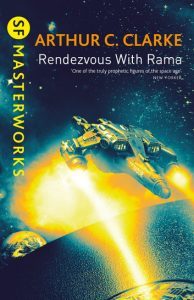
The year is 2131. Aboard the Solar Survey ship Endeavour, Commander Bill Norton and a team of scientists are on a mission to intercept and glean what information they can from an alien spacecraft as it hurtles through our solar system. The alien ship, dubbed Rama after the Hindu god, is a gargantuan hollow cylinder. The Endeavour lands on one end and the crew enter Rama through a series of airlocks to explore the interior of what appears to be a dead world. It’s a shame the ship is derelict, but not surprising; projecting its trajectory backwards to find the nearest star it could have launched from suggests it has been in flight for at least two hundred thousand years, perhaps longer.
The explorers are competent professionals, dealing with one problem after another as they penetrate further into Rama’s secrets. They are awed but not terrified of it, and take care not to inflict unnecessary damage.
But as they draw closer to the sun, Rama comes to life…
Rendezvous with Rama by Arthur C. Clarke is a hard science fiction classic. (Hard meaning grounded in physics, chemistry, and the other natural sciences. Don’t be put off by that; the language is accessible to the average person. I first read this in high school, and later to my daughter when she was ten. We frequently went off on tangents explaining things, but she understood it well enough to enjoy the story.) Published in 1973, this First Contact novel has been a strong influence on many others written since.
This novel is all about world building, although not in the sense of that term as it is so often used to justify interminable descriptions and boring backstory. Clarke’s prose is lean—my copy is only 274 pages—but he gives us enough sensory details to capture the explorers’ experiences and enough explanations from physics and the other sciences to underpin the validity of his imagined world. Characterisations are weak, and there’s hardly any plot to speak of. The journey of exploration is the destination here.
Wonder and optimism are essential components of this story. Wonder at the technological prowess and long-term thinking of Rama’s builders. Optimism that we humans, given enough time and resources and the will to overcome our divisions, could do something equally grand. The story ends with unanswered questions—Who built Rama? Where did it come from? Where is it going?—but that’s fine. This is a book to feed the imagination, and to stretch our sense of scale. Not to make us feel wretched for our insignificance; rather to broaden our horizons and nudge us out of our egocentrism.
Audience: Everybody. A few hints at off-screen sex, but no violence or bad language.
Rendezvous with Rama was intended to be a stand-alone novel, and is fine to be read that way. About fifteen years later, another author wrote several sequels, with some input from Clarke, but the sequels are dismal and disappointing. They are more about human shortcomings than aspirations, and take the story in a direction that is, to my mind, in conflict with the original. Mouse over for spoiler. Don’t bother with them.
July 14, 2018
Thirteen Orphans
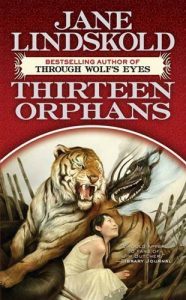
Years ago in the Land Born of Smoke and Sacrifice, a China-like alternate reality, the winners in a war exiled the losers into our reality. The exiles—the young emperor and his twelve advisors, each personifying an animal in the Chinese zodiac—went first to China, but most eventually arrived in the United States, where their oddities were less apparent, and settled down, blending in but not forgetting.
But now, something is attacking the 21st-century descendants of those exiles. The ones attacked are not dead, but have had memories stolen, and it is evident to those who knew them that they are not the same people they once were.
Gaheris Morris, the Rat, is one of those attacked. His 19-year-old daughter, Brenda, joins forces with the other exiles as the Tiger—Pearl, an elderly half-Jewish former actress—calls them together to defend themselves. Their battles play out among the shopping malls and suburban streets of San Jose, California, with weapons ranging from swords to thrown spell papers. Brenda, who had known nothing about her father’s heritage, receives a crash course on magic and history. If she is going to restore her father’s memories and protect her new friends, she will have to grow into the role of the Rat, and she’ll have to do it fast.
The urban fantasy Thirteen Orphans, by Jane Lindskold, is slow moving and much too talky. Aside from that, there’s a lot to like. The cast is intelligent, diverse, and well-drawn, with both Brenda and Pearl formidable women. The book is filled with details that ground the story in modern America, San Jose in particular, and the Chinese culture-based magic, like divination using personalised mah-jong sets, was appealing. (Lindskold has gotten some flak, I believe, for cultural appropriation. I can’t say whether or not that’s justified. I just know I found it a nice change from the seemingly ubiquitous medieval European-based fantasies.)
But most of all I liked that the Orphans acted like rational adults, banding together and working as a team, something that doesn’t seem to happen often in modern fantasy. (Yes, I know, conflict is necessary for dramatic tension, but some writers throw in so many personality quirks and conflicts that I want to shake their characters and say, “Grow up!”) Even their opponents, once revealed, are mostly honourable people dealing as best they can with a bad situation. That made for a more complex and satisfying conclusion than banishing yet another one-dimensional evil villain would have.
Thirteen Orphans is the first in a trilogy. I haven’t read the others yet, but the second book, Nine Gates, is waiting in my To Be Read pile.
Audience: Adults down through mid-teens. No sex or bad language. Some violence but no gore.
Thirteen Orphans
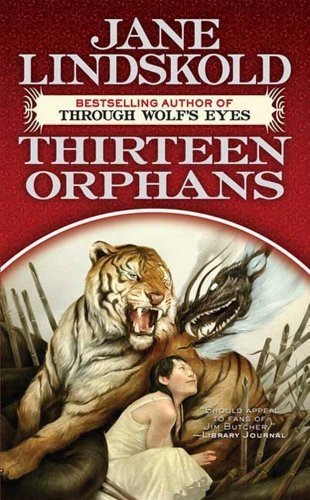
Years ago, in the Land Born of Smoke and Sacrifice, a China-like alternate reality, the winners in a war exiled the losers into our reality. The exiles—the young emperor and his twelve advisors, each personifying an animal in the Chinese zodiac—went first to China, but most eventually arrived in the United States, where their oddities were less apparent, and settled down, blending in but not forgetting.
But now, something is attacking the 21st-century descendants of those exiles. The ones attacked are not dead, but have had memories stolen, and it is evident to those who knew them that they are not the same people they once were.
Gaheris Morris, the Rat, is one of those attacked. His 19-year-old daughter, Brenda, joins forces with the other exiles as the Tiger—Pearl, an elderly half-Jewish former actress—calls them together to defend themselves. Their battles play out among the shopping malls and suburban streets of San Jose, California, with weapons ranging from swords to thrown spell papers. Brenda, who had known nothing about her father’s heritage, receives a crash course on magic and history. If she is going to restore her father’s memories and protect her new friends, she will have to grow into the role of the Rat, and she’ll have to do it fast.
The urban fantasy Thirteen Orphans, by Jane Lindskold, is slow moving and much too talky. Aside from that, there’s a lot to like. The cast is intelligent, diverse, and well-drawn, with both Brenda and Pearl formidable women. The book is filled with details that ground the story in modern America, San Jose in particular, and the Chinese culture-based magic, like divination using personalised mah-jong sets, was appealing. (Lindskold has gotten some flak, I believe, for cultural appropriation. I can’t say whether or not that’s justified. I just know I found it a nice change from the seemingly ubiquitous medieval European-based fantasies.)
But most of all I liked that the Orphans acted like rational adults, banding together and working as a team, something that doesn’t seem to happen often in modern fantasy. (Yes, I know, conflict is necessary for dramatic tension, but some writers throw in so many personality quirks and conflicts that I want to shake their characters and say, “Grow up!”) Even the Orphans’ opponents, once revealed, are mostly honourable people dealing as best they can with a bad situation. That made for a more complex and satisfying conclusion than banishing yet another one-dimensional evil villain would have.
Thirteen Orphans is the first in a trilogy. I haven’t read the others yet, but the second book, Nine Gates, is waiting in my To Be Read pile.
Audience: Adults down through mid-teens. No sex or bad language. Some violence but no gore.
June 29, 2018
The Lord of Dreams
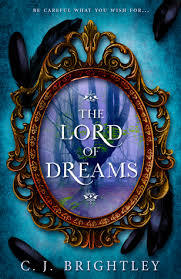
Be careful what you wish for, as you will surely get it.
Claire Delaney, normal American teenager, wishes she could be a hero. She is immediately snatched out of her bedroom by a delightfully dangerous figure, transported into the world of the fae, and sent on a mission to rescue an imprisoned fairy. In the next few chapters of The Lord of Dreams by C J Brightley, we follow the disoriented Claire as she wanders randomly through a kaleidoscopic and strangely barren dreamscape. Nothing makes much sense; the fae king who sends her into this world calls himself her villain and the other few characters she interacts with seem determined to insult her and avoid telling her anything useful. She does eventually find and rescue the fairy, without understanding who he is or why he was imprisoned.
I struggled with that bit, the first 20% or so of the book. I didn’t like not understanding what was going on, and it annoyed me that Claire never stopped to ask herself why she should obey the fae king’s order if he was the villain. She seemed passive, letting herself be pushed around and not thinking things through. I was about to toss the book on the Did Not Finish pile, when things changed. For a few chapters the story bounces back and forth between strange dreams and normal life. Claire grows up and is in grad school when the fae come to her again, asking for her help. They are at war, their king—the nightmare figure from her dreams—has been captured, and he had predicted that she would be the one to rescue him.
From then on, the story’s focus is more clear, and I devoured the rest of the book in one Sunday afternoon and evening. It’s a nice combination of heroic quest, self-discovery, and gentle romance set in the world of the Seelie and Unseelie from the folklore of the British Isles.
Claire improves, acting with more agency, learning to ask the right questions, and overcoming her initial prejudice against the fae king. By a third of the way through, I had also learned to roll with unanswered questions. I did eventually get answers, but some of them were a long time coming. That was OK, as the gist of the story was about Claire making sense of this strange world she’s been thrown into, and understanding the full import of the breathtaking gamble the king has made. If we’re not a bit disoriented, too, how can we appreciate the mental leaps she has to make?
The story was not entirely successful. In particular, Claire’s relationship with her family was unsatisfying. I wish that plot thread had either been given more attention or dropped. Concern over the deprivations she was suffering from being unable to eat or drink anything in the world of the fae kept pulling me out of the story, too. In Chapter 4 she’s about to collapse from dehydration, but then trudges on for hours (days?) more. (Magical sustenance? Yeah, sure.)
Despite those quibbles, it was a satisfying adventure. Perhaps I liked it as much as I did because I kept seeing parallels with my own novel, The Locksmith: Something valuable is hidden so well its existence is forgotten. A magical entity may or may not be sentient. Magic is shaped by imagination and willpower. Powerful wishes take on a life of their own. Men in peril are rescued by women.
And finally, I learned that if I’m ever pulled into the world of the fae, I should bring along a butter knife…
Audience: Teens and up. Some pain and violence (there is, after all, a war on) but no sex or bad language.
The Lord of Dreams
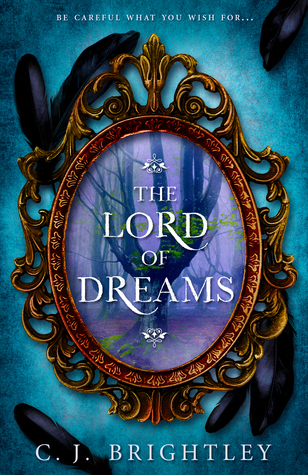
Be careful what you wish for, as you will surely get it.
Claire Delaney, normal American teenager, wishes she could be a hero. She is immediately snatched out of her bedroom by a delightfully dangerous figure, transported into the world of the fae, and sent on a mission to rescue an imprisoned fairy. In the next few chapters of The Lord of Dreams by C J Brightley, we follow the disoriented Claire as she wanders randomly through a kaleidoscopic and strangely barren dreamscape. Nothing makes much sense; the fae king who sends her into this world calls himself her villain and the other few characters she interacts with seem determined to insult her and avoid telling her anything useful. She does eventually find and rescue the fairy, without understanding who he is or why he was imprisoned.
I struggled with that bit, the first 20% or so of the book. I didn’t like not understanding what was going on, and it annoyed me that Claire never stopped to ask herself why she should obey the fae king’s order if he was the villain. She seemed passive, letting herself be pushed around and not thinking things through. I was about to toss the book on the Did Not Finish pile, when things changed. For a few chapters the story bounces back and forth between strange dreams and normal life. Claire grows up and is in grad school when the fae come to her again, asking for her help. They are at war, their king—the nightmare figure from her dreams—has been captured, and he had predicted that she would be the one to rescue him.
From then on, the story’s focus is more clear, and I devoured the rest of the book in one Sunday afternoon and evening. It’s a nice combination of heroic quest, self-discovery, and gentle romance set in the world of the Seelie and Unseelie from the folklore of the British Isles.
Claire improves, acting with more agency, learning to ask the right questions, and overcoming her initial prejudice against the fae king. By a third of the way through, I had also learned to roll with unanswered questions. I did eventually get answers, but some of them were a long time coming. That was OK, as the gist of the story was about Claire making sense of this strange world she’s been thrown into, and understanding the full import of the breathtaking gamble the king has made. If we’re not a bit disoriented, too, how can we appreciate the mental leaps she has to make?
The story was not entirely successful. In particular, Claire’s relationship with her family was unsatisfying. I wish that plot thread had either been given more attention or dropped. Concern over the deprivations she was suffering from being unable to eat or drink anything in the world of the fae kept pulling me out of the story, too. In Chapter 4 she’s about to collapse from dehydration, but then trudges on for hours (days?) more. (Magical sustenance? Yeah, sure.)
Despite those quibbles, it was a satisfying adventure. Perhaps I liked it as much as I did because I kept seeing parallels with my own novel, The Locksmith: Something valuable is hidden so well its existence is forgotten. A magical entity may or may not be sentient. Magic is shaped by imagination and willpower. Powerful wishes take on a life of their own. Men in peril are rescued by women.
And finally, I learned that if I’m ever pulled into the world of the fae, I should bring along a butter knife…
Audience: Teens and up. Some pain and violence (there is, after all, a war on) but no sex or bad language.
June 15, 2018
Have His Carcase
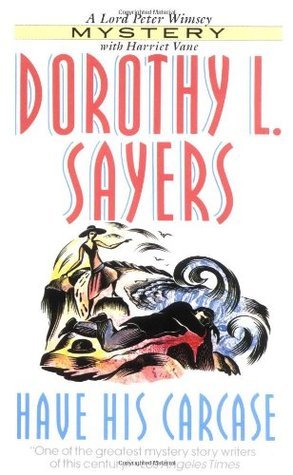
What would you do if you came across the body of a man with his throat cut, so recently dead that the still-liquid blood is running in a glistening stream down the side of the rock he is lying on?
This is the situation facing Harriet Vane in the opening chapter of Have His Carcase by Dorothy L Sayers. Harriet, Sayer’s alter ego and a fictional writer of crime fiction, is on a solitary walking tour of the southern English coast, having finished one novel and not yet ready to start the next. The corpse and its perch are below the high-tide line, and the tide is coming in. Harriet, being a sensible sort, takes several photographs of the corpse and the footprints leading to the rock—hers and the dead man’s are the only ones visible—retrieves the razor responsible for the deed, and sets off to summon the police. (Sayers was writing in the 1930s. There were no cell phones, even landlines were uncommon along a sparsely populated region of the coast, Harriet was on foot, and the nearest town was eight miles away. The corpse was carried away by the tide before she was able to reach the police. If she hadn’t taken pictures they might not have believed her story.)
Have His Carcase is a classic plot-driven story from the “Golden Age” of detective fiction. It is slower moving and more complex, plot-wise, than most mysteries being published now, but many people still enjoy those mysteries for the puzzles they present. Sayers plays by the rules, giving us the clues to match wits with Lord Peter Wimsey and the police as they seek answers to questions: Is Paul Alexis’ death suicide or murder? And if murder, who did it? We discover early on that there is a someone who had good reason to want Alexis dead, and he has been acting suspiciously, but the investigators can’t figure out how he could have had a hand in a murder. In fact, the more they dig, the more they seem to solidify his alibi.
I first read Have His Carcase decades ago, shortly after reading Gaudy Night, where Sayers shifts her focus and delves more deeply into character, making Vane and Wimsey much closer to living, breathing people. Compared to that gem, Have His Carcase was a disappointment. I have reread Gaudy Night several times since, but only recently picked up Have His Carcase for the second time. I admit to being pleasantly surprised at how much fun it was. Not as good as Gaudy Night, but fine in its own right. I only have two quibbles with it:
There is a chapter describing, in eye-glazing detail, how Wimsey and Vane crack a cipher. If you’re keen on ciphers, you can get the gist of it in a few pages. If you’re not, the entire chapter can be skipped without missing anything important.
The exchanges between Wimsey and Vane are entertaining, as one might expect. I just wish there were more of them. In fact, after a strong beginning, focusing on Harriet as an active and intelligent participant in the investigation, she rather fades from view. By the end, the focus has shifted to Lord Peter, and he ultimately unravels exactly what did happen with Harriet listening. Sigh.
I mentioned a strong beginning. The opening paragraph has to be one of my all-time favourites:
The best remedy for a bruised heart is not, as so many people seem to think, repose upon a manly bosom. Much more efficacious are honest work, physical activity, and the sudden acquisition of wealth. After being acquitted of murdering her lover, and indeed, in consequence of that acquittal, Harriet Vane found all three specifics abundantly at her disposal; and although Lord Peter Wimsey, with a touching faith in tradition, persisted day in and day out in presenting the bosom for her approval, she showed no inclination to recline upon it.
Audience: Adult or older teens. No sex or bad language. There is a bit of gore (Alexis did get his throat cut) but the act itself takes place offscreen.
Have His Carcase

What would you do if you came across the body of a man with his throat cut, so recently dead that the still-liquid blood is running in a glistening stream down the side of the rock he is lying on?
This is the situation facing Harriet Vane in the opening chapter of Have His Carcase by Dorothy L Sayers. Harriet, Sayer’s alter ego and a fictional writer of crime fiction, is on a solitary walking tour of the southern English coast, having finished one novel and not yet ready to start the next. The corpse and its perch are below the high-tide line, and the tide is coming in. Harriet, being a sensible sort, takes several photographs of the corpse and the footprints leading to the rock—hers and the dead man’s are the only ones visible—retrieves the razor responsible for the deed, and sets off to summon the police. (Sayers was writing in the 1930s. There were no cell phones, even landlines were uncommon along a sparsely populated region of the coast, Harriet was on foot, and the nearest town was eight miles away. The corpse was carried away by the tide before she was able to reach the police. If she hadn’t taken pictures they might not have believed her story.)
Have His Carcase is a classic plot-driven story from the “Golden Age” of detective fiction. It is slower moving and more complex, plot-wise, than most mysteries being published now, but many people still enjoy those mysteries for the puzzles they present. Sayers plays by the rules, giving us the clues to match wits with Lord Peter Wimsey and the police as they seek answers to questions: Is Paul Alexis’ death suicide or murder? And if murder, who did it? We discover early on that there is a someone who had good reason to want Alexis dead, and he has been acting suspiciously, but the investigators can’t figure out how he could have had a hand in a murder. In fact, the more they dig, the more they seem to solidify his alibi.
I first read Have His Carcase decades ago, shortly after reading Gaudy Night, where Sayers shifts her focus and delves more deeply into character, making Vane and Wimsey much closer to living, breathing people. Compared to that gem, Have His Carcase was a disappointment. I have reread Gaudy Night several times since, but only recently picked up Have His Carcase for the second time. I admit to being pleasantly surprised at how much fun it was. Not as good as Gaudy Night, but fine in its own right. I only have two quibbles with it:
There is a chapter describing, in eye-glazing detail, how Wimsey and Vane crack a cipher. If you’re keen on ciphers, you can get the gist of it in a few pages. If you’re not, the entire chapter can be skipped without missing anything important.
The exchanges between Wimsey and Vane are entertaining, as one might expect. I just wish there were more of them. In fact, after a strong beginning, focusing on Harriet as an active and intelligent participant in the investigation, she rather fades from view. By the end, the focus has shifted to Lord Peter, and he ultimately unravels exactly what did happen with Harriet listening. Sigh.
I mentioned a strong beginning. The opening paragraph has to be one of the all-time classics:
The best remedy for a bruised heart is not, as so many people seem to think, repose upon a manly bosom. Much more efficacious are honest work, physical activity, and the sudden acquisition of wealth. After being acquitted of murdering her lover, and indeed, in consequence of that acquittal, Harriet Vane found all three specifics abundantly at her disposal; and although Lord Peter Wimsey, with a touching faith in tradition, persisted day in and day out in presenting the bosom for her approval, she showed no inclination to recline upon it.
Audience: Adult or older teens. No sex or bad language and the one violent act takes place offscreen.
June 3, 2018
Léon and Louise

Léon and Louise, by Alex Capus, is a charming love story, but is not a formulaic romance. The book spans decades and two wars, and the two title characters spend far more time apart than they do together. They meet in the final year of World War I, and are both gravely injured in the German final offensive. Léon, believing Louise dead, goes on with his life. The story skips ahead a decade, and he has a wife and children before discovering Louise alive on a passing train in the Paris Metro. From there on, Léon’s wife, Yvonne, is as strong a presence in the book as is Louise, and it becomes a story more about three people discovering the complexities of love and coming to terms with their own and their partners’ idiosyncrasies than it is about youthful passion.
It is also a story about ordinary people struggling to carry on normal lives under extraordinary circumstances. While Louise travels to Africa during World War II as part of the Bank of France contingent safeguarding the French gold reserves from the Nazis, Léon and Yvonne remain in Paris under the thumb of the occupying Germans.
I was left with several indelible images, among them Louise, with no hands on the handlebars, pedalling a rusty, squeaking bicycle and easily passing Léon puffing away on his. Léon searching station after station of the Paris Metro for Louise while the strawberry tarts he had bought for Yvonne slowly disintegrate. Léon stuffing 100-franc notes into strangers’ letterboxes, dispersing the bribes forced on him by his despised German overseer.
Written in German by a Swiss author, based on events in his French grandfather’s life, the book has been beautifully translated into English. The story is told with a light touch, almost breezy in places, with only glancing references to the emotional weight of some of the events. Because we must read between the lines and fill in the gaps from our own experience, different readers may have widely varying perceptions of the emotional depth of the story. For example, when an SS agent coerces Léon into line through deliberate cruelty to his daughter, all we are given of Léon’s reaction is that he pushed his chair back with a jerk. Some readers may think him cold and detached. Others, like me, who have had a visceral reaction to the threats expressed in the previous paragraph and who know what we would do for our own children in such circumstances, approve of his self-control in not giving voice to the hot rage and cold horror he must have been feeling.
Like any story where there is as much going on under the surface as above, Léon and Louise benefits from a slow reading. This is a book to savour, not rush through.
Audience: Adults and older teens. A little mild sex and impersonal violence.



